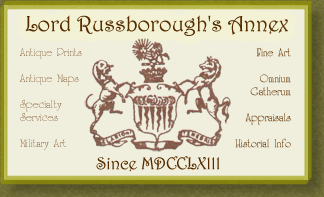 |
 |
 |
 |
 |
 |
 |
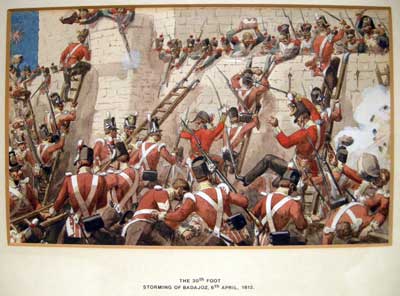
Simkin R. The 30th. Foot Storming of Badajoz, 6 April 1812
Watercolour, Signed (Bottom Right) titled on mount, matted, glazed, gilt-wood frame
8 3/4 x 10 1/2" ( 22.2 x 26.2 cm) Frame: 14 1/2 x 19"
The siege was one of the bloodiest in the Napoleonic Wars and was considered a costly victory by the British, with some 4,800 Allied soldiers killed or wounded in a few short hours of intense fighting during the storming of the breaches as the siege drew to an end. Wellington is reported to have wept at the sight of so many casualties.
The 2nd Battalion, 30th (Cambridgeshire) Regiment of Foot embarked for Portugal in March 1809 for service in the Peninsular War. It fought at the Siege of Badajoz in March 1812: the battalion's losses were 6 officers including the commanding officer, Lieutenant Colonel George Grey, and 132 other ranks. It also saw action at the Battle of Salamanca in July 1812; at Salamanca, Ensign John Pratt, a junior officer in the battalion, captured the French Imperial Eagle of the 22nd Regiment de Ligne. It went on to fight at the Siege of Burgos in September 1812 before returning home in December 1812. The battalion subsequently landed in Holland and fought at the Battle of Quatre Bras and the Battle of Waterloo in June 1815.
Ref. 632 RY16 (179)/AOL /r.ando>VOL PRICE CODE D
|
 |
 |
 |
 |
 |
 |
 |
 |
 |
 |
 |
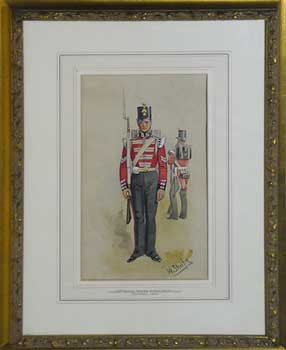
Charles William Sharpe
British 1818-1899
23 Royal Welsh Fusiliers Corporal 1855
A detailed uniform study facing both to the front and rear
Watercolours on paper, Signed (bottom Right) French lines and wash panel matted, non-glare glazed, gilt-wood frame.
10 3/4 x 6 1/8 (27.3 x 15.6 cm.) Frame 18 1/2 x 14"
Ref. 647 CB3 (186)/ DNN/ a.anan > RVL PRICE CODE B
The Welch Regiment of Fusiliers; the prefix "Royal" was added in 1713, then confirmed in 1714 when George I named it The Prince of Wales's Own Royal Regiment of Welsh Fusiliers. After the 1751 reforms that standardized the naming and numbering of regiments, it became the 23rd Foot (Royal Welsh Fuzileers).
It retained the archaic spelling of Welch, instead of Welsh , and Fuzileers for Fusiliers; these were engraved on swords carried by regimental officers during the Napoleonic Wars. After the 1881 Childers Reforms, its official title was The Royal Welsh Fusiliers, but "Welch" continued to be used informally until restored in 1920 by Army Order No.56.
Charles William Sharpe (1818-99) was known for his engravings after his contemporaries such as Daniel Maclise, W.P. Frith and Alma-Tadema.
Provenance: Parker Gallery London 1981
Private collection Mississauga 1981- 2020
|
 |
 |
 |
 |
 |
 |
 |
 |
 |
 |
 |
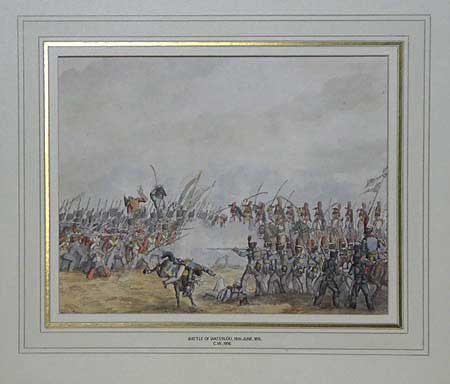
C. W.
Attributed to
Col. Charles Waller
19th. Cent. British School
The Battle of Waterloo 1815
Watercolours on paper 1816 inscribed( bottom left ) with Monogramme ‘CW’
French lines and wash panel mat.
9 x 11 3/8 (22.9 x 28.9 cm.)
Ref. 645 CB1(186)/ RNN/ a.anan > VNN SOLD PRICE CODE C
Sabers flash and musket fire is exchanged, as a French column advance upon the British square of serried ranks of determined fire, only to be repelled during the Battle of Waterloo 1815. Uniform details are not clear, but we believe depicted are Third Regiment of Foot Guards (now Scots Guards), French Cuirassiers and Régiment d’Infanterie de Ligne.
The standard infantry weapon across all the armies was the muzzle-loading musket. The musket could be fired three or four times a minute, throwing a heavy ball inaccurately for a hundred metres or so. Each infantryman carried a bayonet for hand-to-hand fighting, which fitted the muzzle end of his musket.
Provided the infantry were able to form square, they were largely impervious to cavalry attack by the French Cuirassiers, as neither the British nor the French cavalry horses could be brought to ride through an unbroken infantry line and the infantry could not be attacked in flank.
The Battle of Waterloo was fought on Sunday, 18 June 1815 near Waterloo in Belgium, part of the United Kingdom of the Netherlands at the time. A French army under the command of Napoleon Bonaparte was defeated by two of the armies of the Seventh Coalition: an army consisting of units from the United Kingdom, the German Legion, the Netherlands, Hanover, Brunswick and Nassau, under the command of the Duke Of Wellington, referred to by many authors as the Anglo-allied army, and a Prussian army under the command of Field Marshal Blücher. The battle marked the end of the Napoleonic Wars. It is regarded as one of the decisive battles of British History, and was the battle that ended the dominance of the French Emperor Napoleon over Europe; the end of an epoch.
C.W. believed to be Col. Charles D. WALLER ƒl. 1795-1826
An artillery officer and amateur topographer, who was a pupil of Paul Sandby at Woolwich. His work is close to that of the master. He entered the Royal Artillery in 1788 promoted Captain 1795 and a full Colonel in 1819 From 1818 to 1826 he commanded Charlemont Fort in Co. Armagh.
Provenance: Parker Gallery London 1992
Private collection Mississauga 1992- 2020
|
 |
 |
 |
 |
 |
 |
 |
 |
 |
 |
 |
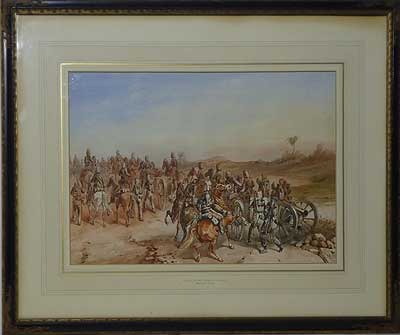
Orlando NORIE
British - 1832-1901
Artillery on the march to Lucknow
Watercolours on paper, Signed (bottom Right) French lines and wash panel matted, glazed, ornate black and gilt-wood Hogarth style frame with gilt corners. 12 3/8 x 18 3/8" (31.3 x 46.7 cm) Frame 20 ¾ x 27 ¼ "
Ref. 646 CB2 (186)/ RNN/ a.anan > SNN PRICE CODE D
Click here for larger image.
A horse shy’s at a sudden noise as its rider tenses to control it, as a train of two guns and troops of the Royal Artillery are on the march toward Lucknow, in order to raise the siege. The dust of semi-arid landscape of that hot June/August 1857 is apparent in the hot weather uniforms of the mounted troops and other foot ranks. The eventual relief of the siege uncovered unspeakable conditions. Atrocities and acts of revenge ended the Indian Mutiny and the abolition of the East India Company in 1858.
Orlando Norie (1832–1901), artist of military subjects, perhaps the most prolific painter of the British army in the 19th. Century along with Richard Simkin It has been estimated that Norie alone painted well over 5,000 pictures. Although his family were of Scottish descent, they had moved to the continent, and Orlando was born in Bruges, Belgium on 15 January 1832. He spent most of his working life in Dunkirk where he painted many scenes, primarily in watercolour by the firm of Rudolf Ackermann.
His work was first recognized in the autumn of 1854 when his print of the Battle of Alma was advertised. This was followed by prints of the Battle of Inkerman and the Battle of Balavlava, all for Ackermann's. This company's Eclipse Sporting and Military Gallery served as an outlet for many of the artist's watercolours. Norie was viewed as the natural successor to Henry Martens, and Ackermann's were so pleased with his work that they occasionally profiled him in exhibitions, one of which was staged in 1873 to showcase his pictures of the recent Autumn Manoeuvres held in September and October 1871 around Aldershot and the Surrey heaths.
A watercolour painting depicting the Battle of Fuentes de Ofioro 5 May 1811, by Orlando Norie is in the collection of the Royal Military College of Canada. His grave is in the old cemetery of Dunkirk adjacent to the Commonwealth War cemetery. Today, many of his pictures can be seen in British regimental museums and clubs.
Provenance: Parker Gallery London 1976
Private collection Mississauga 1976- 2020
|
 |
 |
 |
 |
|
 |







